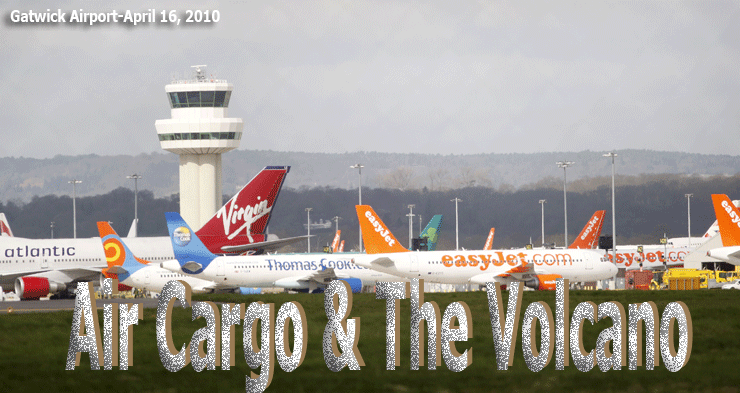Air Cargo & The Volcano

 Ram
Menen, Senior Division Vice President at Emirates SkyCargo (right) talks
about the volcano that shut down much of the world airline schedules
this way: Ram
Menen, Senior Division Vice President at Emirates SkyCargo (right) talks
about the volcano that shut down much of the world airline schedules
this way:
“It is quite a challenging situation.
“A bit like what happened post 9/11 in the U.S. where all the
air space shut down . . . air traffic into and out of the northern part
of Europe is paralyzed and that affects everyone.
“We are monitoring the situation very closely and keeping our
customers advised of the situation via regular communiqué and our website.
“Let us hope this will not last long and life can get back to
normal.”
 But
Dave Brooks, President of American Airlines Cargo (left), never at a
loss for words spoke of the exasperation that people around the world
in air cargo feel about the roller coaster 2000s saying simply: But
Dave Brooks, President of American Airlines Cargo (left), never at a
loss for words spoke of the exasperation that people around the world
in air cargo feel about the roller coaster 2000s saying simply:
"What's next, locusts?
“All we can do is communicate, communicate, communicate.
“Most customers know we can't control volcanoes; they just want
to be kept in the loop."
As the 40th annual celebration of Earth Day approaches on April
22, 2010, we have been given more than a gentle reminder from Mother
Nature that we are still just guests on her planet. While most of us
are going about the quotidian routine of our lives driving to work,
cursing the traffic, making dinner and laughing at our television sets,
only miles above our carefree heads the air has grown toxic and thick
with ash.
A volcano near Iceland’s Eyiafjallajokull glacier has been spewing
ash clouds into the air since Wednesday, bringing air traffic in parts
of northern and western Europe to a standstill. Some volcanists are
now saying that disruptions to air traffic could last for several months
due to the very fine composition of ash particles, which are miniscule
enough to invade all parts of an airplane and so lightweight they tend
to remain in the air for up to two to three years before dispersing.
Not since the tragedy of 9/11 has the commercial airline business
taken such an unexpected and widespread hit.
The groundings and diversions come at a time when airlines are
beginning to report positive results with business slowly returning."I
would expect this shutdown to last a couple of days," said Prof Bill
McGuire of the Aion Benfield UCL Hazard Research Center.
"But if the eruption continues—and continues to produce ash—we
could see repeated disruption over six months or so."
Other experts think that future threats from the volcano to Europe
aviation will be occasional.
"What has happened overnight is that the volcano has . . . exploded
quite a lot more violently and put ash very high up," said Matthew Watson,
lecturer on geophysical natural hazards at Bristol University told CNBC.
"If it does go back to what it's doing before—and I don't have
a crystal ball but I would think that is quite likely—then essentially
what you are doing is waiting for the airspace to clear."
The southeast drifting cloud, floating roughly between 6,000 and
8,000 meters above surface forced national civil aviation authorities
to close many parts of the European airspace, mainly above Scandinavia,
the UK, the Benelux countries, France, Germany, the Baltic States, and
Poland.
A large number of airports were shut down Thursday, among them
all British airports, Paris, Amsterdam, Hamburg, Berlin, Copenhagen
and Brussels. Eurocontrol reported the skipping of about 4,000 flights
on Thursday.
Today some 28,000 flights are said to have been cut to about 11,000
with long-haul flights diverted, returned to their departure cities,
or totally cancelled leaving hundreds of thousand passengers stranded
and huge cargo tonnage on the ground.
Speaking of air cargo right now Europe is scrambling to get as
much long haul freight as possible on the road for delivery to offset
loss of airlift.
Most important thing when something like this happens is for everyone
to stay in touch with each other so everyone knows what to expect
 Lufthansa
Cargo spokesman Nils Haupt (left) said: “We are in meetings every
four hours with our crises team to update the situation and expect to
be back in operation by 2000 hrs. Saturday April 17. Lufthansa
Cargo spokesman Nils Haupt (left) said: “We are in meetings every
four hours with our crises team to update the situation and expect to
be back in operation by 2000 hrs. Saturday April 17.
“Of course this is our estimate based on best information available.
“Most important thing when something like this happens is for
everyone to stay in touch with each other so everyone knows what to
expect.
“Right now we have just one MD11 freighter on the ground here
in Frankfurt with the rest of the fleet standing by at airports all
over the world.
“For someone who has kero in the veins, no aircraft movement at
Frankfurt Main today is quite strange and unnatural.”
 Neel
Shah, (right) VP Cargo, Delta Airlines told Air Cargo News FlyingTypers: Neel
Shah, (right) VP Cargo, Delta Airlines told Air Cargo News FlyingTypers:
“Since DL is the number one carrier across the Atlantic, this
situation has had a tremendous impact.
“We have already cancelled 65 flights between yesterday and this
morning and that number is climbing every hour as more European Airspace
is closed as a result of the ash cloud.
“Our flights are booked close to capacity for both passengers
and cargo so it is going to be challenging recovering from the past
couple of days.
“It is our hope that we can get back to a normal operation by
Sunday but it’s way too early to tell if that will be possible.”
“Volcanic ash is indeed, Kryptonite for air cargo.” Said Tony
Randgaard, spokesperson for Continental Airlines Cargo.
“Like everyone else, we are watching the satellite maps and wondering
what Mother Nature has in store for today.
“On Thursday, Continental was forced to cancel 30 flights and
unable to operate into Scandinavia or the UK.
“We suggest that customers keep in touch with our Cargo Customer
Service Center for the latest news.”
Typically air cargo people are meeting strategizing and working
around the clock to keep the goods moving.
“Capacity restraints are words of the day,” said one big carrier
of mail who interlines outbound from USA.
“But we are dealing with restraints by moving cargo over the road
to airports other than major gateways here (LAX/JFK) while watching
every minute to be first to take advantage of the moment when LHR and
other EU gateways return.”
But no amount of diverting or other attempts can get into closed
airspaces.
Platinum Cargo, a big U.S.- based GSA is typical of scores of
notices flooding emails right now to customers, advising business as
usual will be unusual until the airports get back online.
Eurocontrol, the 38-states agency coordinating European air traffic,
spoke of an “unprecedented situation” having so much airspace and airports
closed. With ongoing volcanic activity and southeastern air drift, European
air traffic could be disrupted for longer. Meteorologists hesitate giving
any predictions because of the uncertain geothermic activity and atmospheric
situation.
The Mid-Atlantic Ridge divides the isle of Iceland where the European
and North American plates drift apart causing frequent volcanic eruptions.
“Ashes spouted from volcanoes represent a significant threat to air
traffic,” warned Eurocontrol in a Thursday-issued statement.
The drifting particles of silicate can penetrate and severely
damage turbines bringing them to a halt.
This occurred in 1989 when a KLM Boeing 747 en route from Amsterdam
to Alaska flew across an ash cloud spewed in the atmosphere by Mount
Redoubt of the Aleutian Range.
All four engines lost power, which were restored shortly, averting
the aircraft from crashing.
A similar incident happened in 1982 to a British Airways B747
flying from Great Britain to New Zealand hitting volcanic ashes coming
from Indonesian volcano Mount Gulanggung.
All four engines failed but were restarted by the cockpit crew
after they managed to glide the aircraft far enough to escape the ash
cloud.
Volcanoes may seem exotic, but there are plenty of them right
here in USA. According to the U.S. Geological Survey (USGS), there are
67 active or potentially active volcanoes in the United States: seven
in Hawaii, 16 in mainland Alaska, 24 in the Aleutian Islands, five each
in Washington and Oregon, one each in Arizona and New Mexico, and two
in Idaho, including Yellowstone National Park, which includes parts
of Montana and Wyoming.
Interestingly, ScienceCentral.com reports,” more than twenty years
after Mount St. Helens in Washington state USA erupted, scientists still
can't predict eruptions precisely.
“But they are better equipped to help determine when it’s time
to evacuate an area, in a way that's safer for the scientists, too,
says C. Dan Miller, chief of the Volcano Disaster Assistance Program
at the USGS Cascades Volcano Observatory.
“Our strategy now is to take out a bunch of monitor equipment,
install these stations all over the volcano, and then go back to a safe
place and watch the data come in, in real time," says Miller.
"When one looks at these kinds of natural phenomena, volcanic
eruption, you always think of the impact on human lives," Bernard Chouet,
a seismologist at the USGS, told the U.S. Public Broadcasting television
science program NOVA.
"The ultimate quest is to understand enough about the activity
in that volcano to be in a position to make a prediction, predict the
occurrence of an eruption."
Heiner/Geoffrey/Flossie Arend
|



